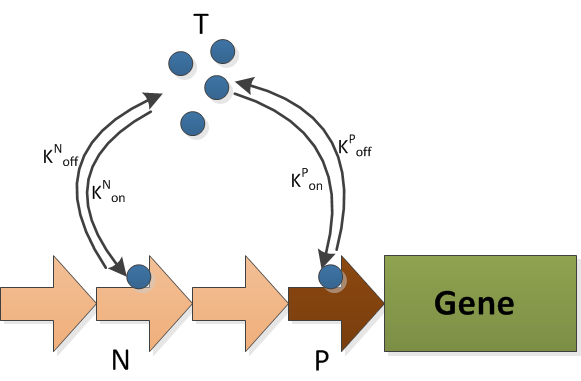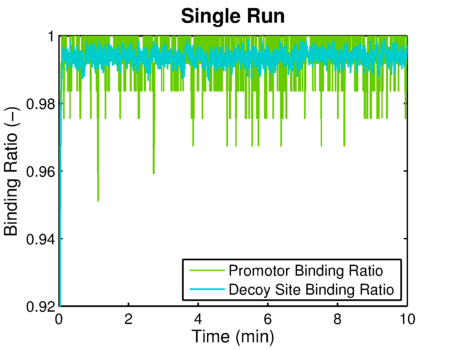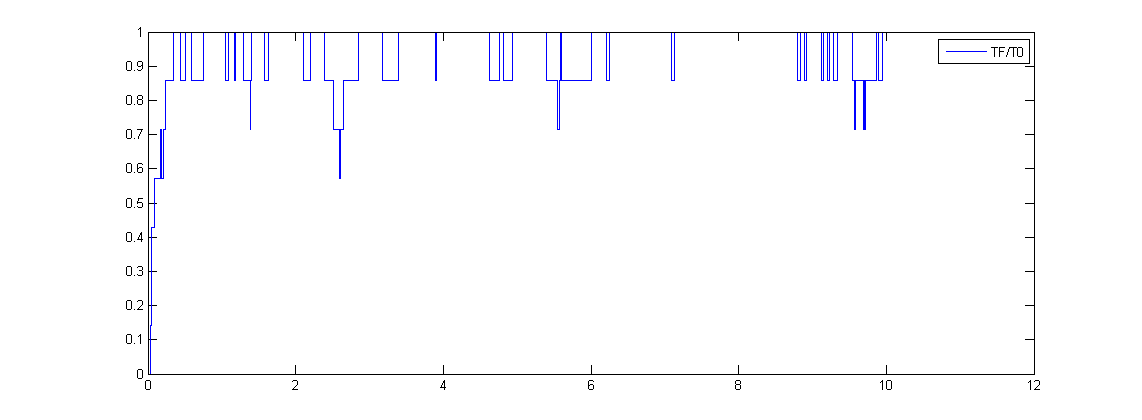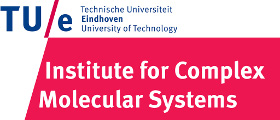Team:TU-Eindhoven/StochasticModel
From 2013.igem.org
Pascalaldo (Talk | contribs) (→Copy Number) |
Pascalaldo (Talk | contribs) (→Simulation Result) |
||
| Line 29: | Line 29: | ||
==Simulation Result== | ==Simulation Result== | ||
| - | + | This model will later on be used for simulations of the complete system we designed. Some results of solely the decoy site model are shown below. ## and ## show the binding ratios calculated by either one or multiple stochastic simulations. | |
{{:Team:TU-Eindhoven/Template:Image | filename=stochFNR.png }} | {{:Team:TU-Eindhoven/Template:Image | filename=stochFNR.png }} | ||
Revision as of 13:13, 30 September 2013



Contents |
Decoy Sites
To tune the level of protein expression, we used decoy sites. Decoy sites are tandem repeats of DNA where transcriptional factor can bind to but don't promote gene expression. Therefore it competes with promoter sites and lowers the gene expression rate. LeeDecoyTek-Hyung Lee and Narendra Maheshri, A regulatory role for repeated decoy transcription factor binding sites in target gene expression. Molecular Systems Biology 8, 576 (2012)
The Model
Decoy Sites

$$ \eqalignno{ \ce{$T + N\,$ &<=>[\text{Kn-on}][\text{Kn-off}] $TN$} & (1) \\ \ce{$T + P\,$ &<=>[\text{Kp-on}][\text{Kp-off}] $TP$} & (2) \\ }$$
The T is the transcriptional factor, which is FNR. It can binds to either the decoy sites(N) or the promoter(P). The production and degradation of T is included in the FNR model.
Copy Number
The copy numbers refers to the number of certain plasmids in E.coli. In this project we used the derivative of pBR322. So the copy number is between 15 to 20.CopyNr, Growth of Bacterial Cultures. www.qiagen.com/Knowledge-and-Support/Spotlight/Plasmid-Resource-Center/Growth%20of%20bacterial%20cultures/ , () As the plasmid has a low copy number, we take the average of copy number and multiple it with the amount of promoter and decoy sites.
Protein Expression Rate
The protein expression rate was assumed to be linear to the promoter binding ratio in Tek-Hyung Lee and Narendra MaheshriLeeDecoy. As we have only one promoter in each plasmid, we have either the 'on-state' plasmid or the 'off-state' plasmid. So we take the idea of linearity and convert the assumption to that the protein expression rate is linear to the proportion of 'on-state' plasmid.
Simulation Result
This model will later on be used for simulations of the complete system we designed. Some results of solely the decoy site model are shown below. ## and ## show the binding ratios calculated by either one or multiple stochastic simulations.

The simulated result of decoy site binding ratio
 The simulated result of promoter binding ratio
The simulated result of promoter binding ratio
 This would be the input for the modeling of protein generation. We assume the protein production rate is linear to the promoter binding ratio.LeeDecoy
This would be the input for the modeling of protein generation. We assume the protein production rate is linear to the promoter binding ratio.LeeDecoy
References
 "
"



